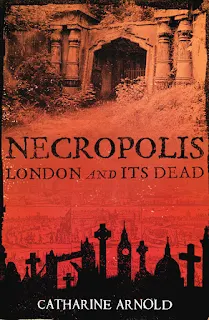According to the blurb:
"The city is one giant grave, filled with the remains of previous eras. The Houses of Parliament sit on the edge of a former plague pit, St Paul's is built over human remains; Underground tunnels were driven through forgotten catacombs, thick with bones."I found the earliest history the least interesting. My fascination really begins as burial space in London and the surrounding areas became cramped and Londoners began to run out of places to bury their dead.
Arnold shines a light into the darkness of countless horrific practices in graveyards all over London. Remains were shoved into crevices within churches, often dug up and relocated to charnel houses or pits without notifying the families and bodysnatchers were a real concern. Some graveyards had significantly grown in height due to the placement of bodies on top of each other in layers that in some cases, the burial grounds were reaching the first floor windows of churches and neighbouring houses.
Many proposed the move away from inner city burials in churchyards and burial plots, and championed the establishment of new cemeteries in consecrated ground in the countryside. Arnold takes us through the movers and shakers across decades and centuries as this began to take form, including the key figures involved in designing these cemeteries.
Countless cemeteries and graveyards are mentioned here including the iconic - and my favourite - Highgate Cemetery, which provides a rich history for amateur sleuths and family historians. Many of the old graveyards scattered throughout London were soon forgotten together with the plague pits which had never been marked with gravestones or markers.
"As time passed, London has constructed houses, churches, streets, entire railway stations, over these mass graves, and it is only by chance that they come to light due to building excavations." Page 65
"In fact, the tunnel curves between Knightsbridge and South Kensington stations because it was impossible to drill through the mass of skeletal remains buried in Hyde Park." Page 2I knew how devastating the Great Fire of London was in 1666, however it was shocking to read:
"Seventy per cent of its houses vanished into the flames. Thirteen thousand buildings, including eighty-nine churches, disappeared for ever." Page 68
After the fires and the razing of so many structures, new construction began and the dead were swiftly forgotten in favour of rebuilding London. Gravestones, rubble and in some cases human remains from the fires were used in the foundations of new buildings.
The horses used in Victorian funerals to pull hearses and mourning coaches were:
"Inevitably, the final remains of many Londoners went into the latest foundations of their great city." Page 172I enjoy fiction set - or written - during the Victorian era with a particular interest in the rituals and etiquette surrounding death and mourning. Arnold gives the reader much to digest in Necropolis, with the introduction of the great Victorian cemeteries and the detailed mourning practices of the era.
The horses used in Victorian funerals to pull hearses and mourning coaches were:
"strong, handsome, blue-black animals, worth 50 [pounds] each, were imported from Holland and Belgium. Constantly in the public eye, they were always well groomed. A patch of grey would be painted out, a thinning mane or tail supplemented with hair from a deceased comrade. Mostly gentle and docile they were sturdy animals." Page 196The introduction of cremation and society's changing attitudes towards it were interesting as were the impact of both world wars on the notion of grief and mourning. Although I could have done without the remarkable level of detail with regard to the individual cemeteries.
Necropolis - London and Its Dead by Catharine Arnold reads like an academic text and isn't for everyone. If you enjoy history, anthropology, urban development, changing attitudes to death and mourning or learning about the macabre, then this is for you.
Carpe Librum!




































I like the sound of this, thanks for sharing your thoughts:)
ReplyDeleteThanks Shelleyrae, I hope you check it out, the author sent me a nice DM via Twitter :-)
ReplyDelete